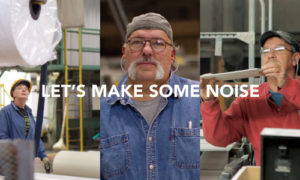SALEM, N.J.—For more than 35 years American companies have been sending jobs, mostly from the manufacturing sector, overseas in search of cheap labor  and less stringent regulations. In fact, the U.S. has not had a trade surplus since 1975 as one company after another shuttered their factories and relocated operations to some other part of the world.
and less stringent regulations. In fact, the U.S. has not had a trade surplus since 1975 as one company after another shuttered their factories and relocated operations to some other part of the world.
The prolonged recession helped to amplify how disproportionate the situation has become as pictures of abandoned warehouses and once-proud manufacturing facilities have been strewn across the country.
Mannington has decided to push back by touting the company’s nearly 100-year-old American heritage. At the heart of the “Let’s Make Some Noise” campaign is a two-and-a-half minute video that showcases Mannington’s people and manufacturing facilities that are mostly located in small cities across the U.S. and how each plays a vital role in their respective communities’ well being, along with those of the country.
As Tom Davis, Manning- ton’s president said, having a strong manufacturing base is more than just jobs. “We feel it helps with U.S. security. For many years the country didn’t seem to care if we lost our manufacturing jobs. Now, protecting U.S. manufacturing is becoming a hot topic in Washington. I’ve worked in manufacturing for 40 years and have been in plants that were shut down; it’s very depressing.”
He noted the country has gone from a point when 30% of its workforce was in U.S. manufacturing. Today it is 10% and falling. Not only have good paying jobs gone by the wayside as a result, but it is a strong part of the demise of many rural communities since that is where the majority of factories were located.
“These were good paying jobs that helped rural America grow and prosper,” Davis added. “It’s not just the jobs in the factory; it’s all the businesses in small communities—from the grocery store, the dinner, the pharmacy, realtors and so on. When a manufacturer shuts a plant down, especially in a small town, it impacts all the ancillary businesses.”
Hence the video, he explained. “We decided to tell our own story to help people think of the manufacturing demise in the country and how important it really is to the U.S.”
Emotional message
To that end, Davis said the video was meant to bring out emotion in the viewer. It opens in silence showing the eyesores of abandoned, shut down and locked up factories. Then, the lights kick on, the machines start churning, people are driving forklifts and working the gears, and the voiceover is actual Mannington employees telling their stories of how great it is to have the opportunity to work for a company that “still believes in America.” The film ends with the mill letting the viewer know it is a fourth- generation, family-owned company that has been around for 100 years and does not plan on stopping any time soon.
Davis admitted he didn’t know what to expect the first time it was shown to him “so I had no preconceived notions going into it.” His reaction? “It brought tears to my eyes; it was powerful. The contrast of the silence to the noise of the factory is striking. It goes from dead to alive and really evokes emotions.”
Going viral
Mannington has officially launched the video on its company website, mannington.com, as well as a special site set up specifically for the campaign, manningtonmakesnoise.com, plus access on YouTube and other social media outlets including Facebook and Twitter.
Along with using traditional methods to get the word out, the company is hoping to make the video a true viral sensation with an email blast, along with encouraging employees to share it with family and friends and promote it in their home communities.
Mannington has set a goal of getting the video viewed at least a half million times. As the story of the U.S. losing its manufacturing base continues to gain headlines, Davis feels this is a legitimate goal, noting there is hope that even the national media may pick up on the video and reference it—and Mannington—when doing a piece on manufacturers committed to keeping their operations in the U.S.
To help keep the campaign going beyond the video, the company ended up with so much footage of employees and their stories that it will be editing them and over time release them on social media as viewers may be interested in hearing the stories of people who have been employed by a U.S. manufacturer for a long time.
“We understand you don’t survive four generations and 100 years without investing in innovation, product design, quality, service and so on,” Davis said. “But we felt awareness needs to be raised about buying American-made products and why it is a good thing.”
-Matthew Spieler
